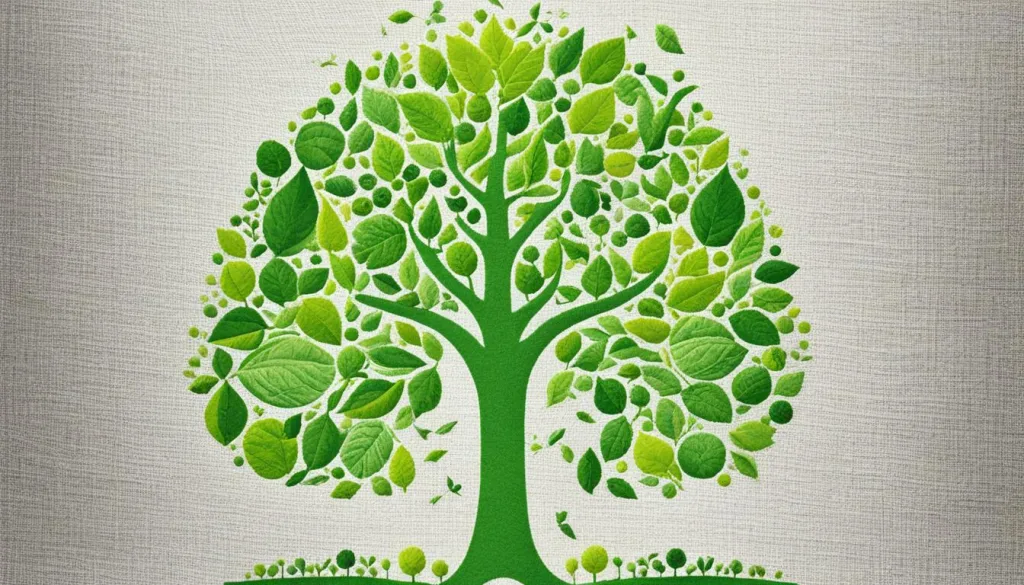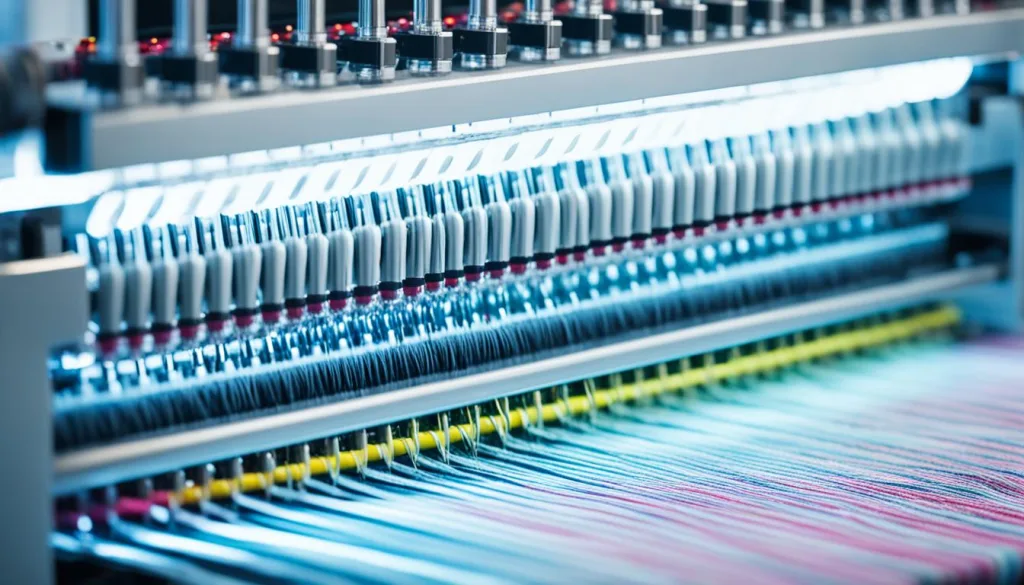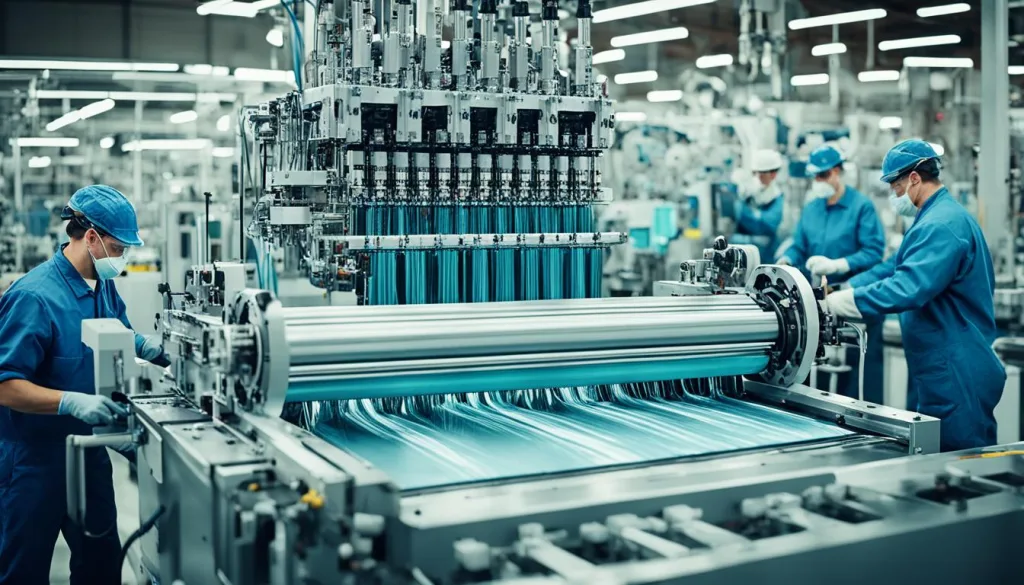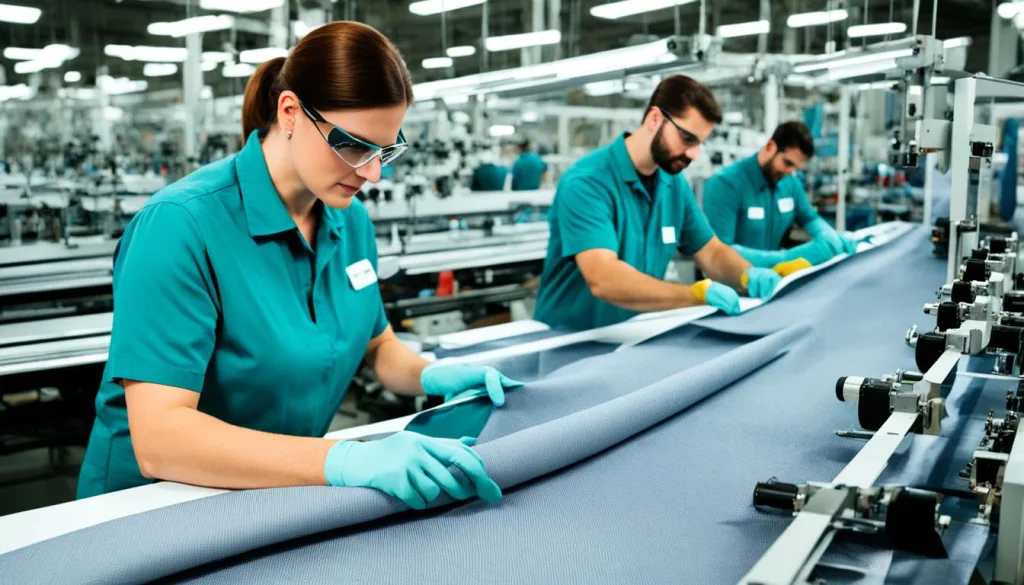This article will explore the latest insights and trends in Textile Manufacturing for 2024. Join us as we delve into the evolving landscape of the textile industry, from fabric production to clothing manufacturing. Discover the innovative advancements in textile machinery, production techniques, and the factory environment. We will also discuss the growing importance of sustainable practices, emerging trends in textile technology, and the global impact of this dynamic industry.
As the textile industry continues to shape the future of fashion and everyday materials, staying updated on the latest developments and trends is essential. Whether you’re a textile producer, a fashion brand, or simply curious about the manufacturing process, this article will provide valuable insights into the exciting world of Textile Manufacturing in 2024.
Key Takeaways:
- Stay informed about the latest insights and trends in Textile Manufacturing for 2024.
- Explore the advancements in textile machinery and production techniques that are revolutionizing the industry.
- Understand the growing importance of sustainable practices in fabric production and clothing manufacturing.
- Discover the latest trends in textile technology, including intelligent textiles, 3D Printing, and wearable technology.
- Gain insights into the global impact of Textile Manufacturing on economies, employment, and trade.
The Evolution of Textile Manufacturing
Textile manufacturing has a rich history that dates back centuries. From its humble beginnings to the modern-day industry, its journey has been driven by innovation, technological advancements, and a never-ending pursuit of excellence. In this section, we will explore the remarkable evolution of Textile Manufacturing and its pivotal role in shaping fabric production and the diverse range of textile products.
Let’s travel back in time to the early days of textile production. Skilled artisans painstakingly crafted fabrics using traditional hand weaving and spinning methods. Their meticulous craftsmanship laid the foundation for the textile industry we know today.
The Industrial Revolution brought about significant changes in Textile Manufacturing as time progressed. The invention of power looms and mechanized spinning machines revolutionized fabric production, enabling more substantial quantities of textiles to be manufactured faster. This transformative era marked a turning point in the history of Textile Manufacturing.
In the 20th century, new manufacturing techniques emerged, further revolutionizing the industry. Synthetic fibers, such as nylon and polyester, gained popularity and opened up new possibilities for textile products. The invention of advanced dyeing and printing technologies allowed vibrant and intricate designs to be incorporated into fabrics.
“Textile Manufacturing has always been driven by innovation and adaptability. From manual craftsmanship to cutting-edge machinery, each era has contributed to the growth and diversification of fabric production.”
Today, Textile Manufacturing continues to evolve rapidly, fueled by technological advancements and a growing emphasis on sustainability. The industry has embraced automation and robotics, streamlining production processes and improving efficiency. Sophisticated machinery has enabled the development of complex textile products, such as technical textiles, for the healthcare and aerospace industries.
The diversity of textile products has also expanded significantly. From traditional clothing fabrics to specialized textiles for industrial applications, the range of products showcases the versatility and adaptability of Textile Manufacturing to various market demands.
Now, let’s take a closer look at some key milestones in the evolution of Textile Manufacturing:
| Period | Major Developments |
|---|---|
| Pre-industrial era | Hand weaving and spinning |
| Industrial Revolution | Invention of power looms and mechanized spinning machines |
| 20th century | Introduction of synthetic fibers and advanced dyeing/printing technologies |
| Modern era | Automation, robotics, and specialized textile production |
As we delve further into this article, we will explore the advancements in textile machinery, sustainability practices, and emerging trends propelling Textile Manufacturing into the future. Join us on this exciting journey through the dynamic world of Textile Manufacturing.
Advancements in Textile Machinery
In the ever-evolving world of Textile Manufacturing, constant innovation is the key to staying ahead. The advancements in textile machinery have played a pivotal role in transforming the manufacturing process, making it more efficient, precise, and productive. Automation, robotics, and AI have revolutionized the way textiles are produced, bringing about a new era of possibilities.
Automation has taken center stage in textile factories, streamlining various operations and minimizing human intervention. Computer-controlled systems ensure consistent quality and reduce the margin of error, resulting in highly standardized textile products. From spinning and weaving to dyeing and finishing, automated machines handle complex tasks with precision and speed.
The use of robotics has further enhanced manufacturing processes. Cutting-edge robotic systems perform intricate tasks that were once labor-intensive and time-consuming. Equipped with advanced sensors, robots can handle delicate fabrics, provide accurate measurements, and ensure precise cuts, enhancing efficiency and reducing waste.
AI has emerged as a game-changer in the textile industry. Machine learning algorithms analyze vast amounts of data, enabling textile manufacturers to optimize production processes, predict demand patterns, and make informed decisions. AI-powered textile machinery can detect flaws and defects, allowing for real-time quality control and minimizing post-production rejections.
With these advancements, textile manufacturers can achieve higher production rates, improved quality standards, and reduced costs. Integrating automation, robotics, and AI enables factories to meet the ever-increasing market demands while maintaining competitiveness in a globalized industry.
“The advancements in textile machinery have transformed the way we manufacture textiles. Automation, robotics, and AI have revolutionized our production processes, making them more efficient and precise. The result is higher productivity, improved quality, and reduced costs.”– Industry Expert
As the textile industry embraces technological advancements, the future holds even greater possibilities. Further integration of AI and machine learning algorithms will enable textile machinery to learn and adapt in real time, optimizing operations and driving continuous improvement.
The Benefits of Advancements in Textile Machinery
The advancements in textile machinery offer numerous benefits to both manufacturers and consumers:
- Increase in production efficiency and capacity
- Consistent quality and standardized textile products
- Reduction in production time and costs
- Minimization of waste and material utilization
- Enhanced precision and accuracy in manufacturing processes
With these benefits, textile manufacturers can meet the demands of a fast-paced industry, cater to consumers’ specific needs, and contribute to the overall growth and evolution of Textile Manufacturing.
| Advancements | Benefits |
|---|---|
| Automation | Increased efficiency and standardized production |
| Robotics | Enhanced precision and reduced waste |
| AI and Machine Learning | Real-time quality control and predictive analytics |
Sustainable Practices in Textile Manufacturing
In today’s rapidly evolving world, sustainable practices have become increasingly important in the Textile Manufacturing industry. As environmental concerns continue to grow, textile producers are embracing eco-friendly initiatives to minimize their environmental impact and create a more sustainable future for textile production.
One of the critical areas of focus in sustainable textile manufacturing is water conservation. By implementing efficient water management systems and adopting technologies that reduce water consumption, textile factories minimize their use of this precious resource. Manufacturers can significantly reduce water usage in their production cycles through innovative processes like water recycling and treatment.
Another critical aspect of sustainability in textile manufacturing is waste reduction. By implementing waste management strategies such as recycling and reusing waste materials, textile producers reduce waste sent to landfills. Additionally, the adoption of circular economy principles, where materials are designed to be easily disassembled and repurposed, is gaining traction in the industry.
Renewable energy sources are also playing a significant role in textile production. Many manufacturers are transitioning to cleaner energy options such as solar and wind power to decrease their reliance on fossil fuels. By integrating renewable energy technologies into their operations, textile factories are reducing their carbon footprint and creating a more sustainable energy model for the future.

These sustainable practices benefit the environment and textile manufacturers. Companies can reduce their operational costs and improve their overall profitability by implementing water- and energy-saving measures.
The shift towards sustainable practices in textile manufacturing is driven by consumer demand for environmentally friendly products. Today’s consumers are increasingly conscious of the environmental impact of their products and are actively seeking sustainable alternatives. Textile manufacturers who embrace sustainability can differentiate themselves in the market and tap into this growing segment of eco-conscious consumers.
As the textile industry continues to evolve, sustainable manufacturing practices will play a pivotal role in shaping its future. By adopting eco-friendly initiatives such as water conservation, waste reduction, and using renewable energy sources, textile manufacturers can contribute to a more sustainable and environmentally responsible textile production process.
Trends in Textile Technology
Stay ahead of the curve with insights into the latest trends in Textile Technology. Explore innovations such as smart textiles, 3D Printing, and wearable technology that are driving the future of clothing manufacturing.

“Technology will continue to revolutionize the textile industry, transforming the way we design, produce, and wear our garments.”
— Emma Anderson, Fashion Technologist at TechFab
Advancements in textile technology have opened up a world of possibilities for the Textile Manufacturing industry. From intelligent fabrics that can monitor body temperature and heart rate to 3D-printed garments that are customized to individual measurements, the future of clothing manufacturing is becoming increasingly high-tech.
Smart Textiles
Bright or e-textiles are fabrics embedded with electronic components such as sensors, actuators, and connectivity systems. These fabrics can collect and transmit data, enabling temperature regulation, moisture management, and interactive features.
For example, innovative sportswear can monitor athletes’ performance and provide real-time feedback, helping them optimize their training. Smart medical garments can track vital signs and transmit the data to healthcare professionals, enabling remote monitoring and early detection of health issues.
3D Printing
The advent of 3D Printing has revolutionized various industries, including Textile Manufacturing. This additive manufacturing technique allows designers and manufacturers to create intricate textile structures using layers of materials, resulting in unique and customized garments.
3D-printed fashion offers advantages such as reduced material waste, faster production times, and the ability to create complex geometries that would be challenging to achieve using traditional manufacturing methods. It also opens up new possibilities for sustainable fashion, allowing for using recycled materials and on-demand production.
Wearable Technology
Wearable technology refers to electronic devices or sensors incorporated into clothing or accessories, enhancing functionality and usability. Wearable technology has gained significant traction in recent years, from fitness trackers and smartwatches to smart glasses and interactive textiles.
These devices can monitor various aspects of our daily lives, such as physical activity, sleep patterns, and stress levels. They also have the potential to improve safety and security with features like GPS tracking and emergency alerts.
With the increasing demand for functional and connected products, the intersection of textiles and technology will continue to shape the future of clothing manufacturing. As the industry embraces these trends, we can expect to see more innovative and efficient production methods, leading to fashionable garments that are also smart and sustainable.
| Trend | Description |
|---|---|
| Smart Textiles | Fabrics embedded with electronic components for enhanced functionality and interactivity. |
| 3D Printing | Additive manufacturing technique for creating complex textile structures and customized garments. |
| Wearable Technology | Electronic devices or sensors are integrated into clothing or accessories to enhance usability. |
Global Impact of Textile Manufacturing
When we think of Textile Manufacturing, the first thing that comes to mind is often the clothes we wear or the fabrics we use in our daily lives. However, the impact of Textile Manufacturing goes far beyond just our consumption. It plays a significant role in economies, employment, and global trade.
Textile Manufacturing is a cornerstone of many economies worldwide, providing employment opportunities and contributing to economic growth. It is a vital industry that supports millions of workers, ranging from cotton farmers and textile factory workers to designers and retailers. The textile industry has become a significant employer, particularly in countries with a rich history in textile production, such as China, India, Bangladesh, and Turkey.
Moreover, the global textile industry fosters international collaborations and partnerships. Manufacturers and suppliers from different countries collaborate to create a global supply chain that ensures the availability of a wide range of textile products. For example, cotton may be grown in one country, woven into fabric in another, and exported to various regions for garment production. This interconnected global network allows for exchanging expertise, resources, and innovation.
Shifting consumer demands also play a crucial role in shaping the global impact of Textile Manufacturing. As consumers become more conscious of sustainability and ethics, the industry adapts to meet these demands. Companies are incorporating eco-friendly practices, such as organic and recycled materials, and implementing fair labor standards throughout the supply chain. These changes fulfill consumer expectations and contribute to a more sustainable future for the industry.
Overall, Textile Manufacturing substantially influences economies, employment rates, and trade worldwide. It is a dynamic industry that continuously adapts to changing consumer preferences, international collaborations, and emerging markets. Understanding the global impact of Textile Manufacturing helps us appreciate its significance in our daily lives and the broader global context.

| Impact area | Key Insights |
|---|---|
| Economies | The textile industry contributes significantly to the GDP of many countries, providing employment and driving economic growth. |
| Employment | Textile Manufacturing offers job opportunities to millions of people across the globe, from cotton farmers to garment workers. |
| Global Trade | The textile industry relies on international collaborations to create a global supply chain, ensuring the availability of diverse textile products worldwide. |
| Consumer Demands | Changing consumer preferences shape the industry and drive sustainability and innovation in ethical practices. |
Quality Control in Textile Manufacturing
As manufacturers in the Textile industry, we understand the paramount significance of delivering high-quality textiles and garments to our customers. Quality control is pivotal in ensuring our fabric and clothing manufacturing processes meet stringent industry standards. Let’s delve into the world of quality control and how it enhances our commitment to excellence.
The Rigorous Testing Processes
From fabric strength and durability to colorfastness and shrinkage, our quality control measures encompass a range of meticulous testing processes. Each step of the textile manufacturing journey undergoes rigorous scrutiny to detect deviations from our high-quality standards. By scrutinizing the quality at various stages of production, we can identify and rectify any potential defects, ensuring that our customers receive only the finest textile products.
Compliance with Industry Standards
Adherence to industry standards is a non-negotiable aspect of our quality control framework. We align our manufacturing processes with internationally recognized standards and certifications to ensure that our fabric production and clothing manufacturing meet or surpass our customers’ expectations. By maintaining strict compliance, we instill trust and confidence in our customers, knowing they receive textiles and garments of the highest caliber.
Innovative Technologies for Quality Assurance
Embracing innovative technologies is crucial in our pursuit of maintaining optimal quality control. We leverage state-of-the-art equipment and cutting-edge technologies to identify and rectify potential flaws or inconsistencies in our textile manufacturing processes. This enables us to enhance precision, improve efficiency, and consistently deliver superior products to our customers.

“Quality control is not just a process; it’s a commitment to excellence and meeting the highest standards in textile manufacturing. By ensuring the quality of our fabric production and clothing manufacturing, we strive to exceed our customers’ expectations and establish long-lasting partnerships.” – Jane Wilson, Quality Control Manager
A Comprehensive Approach to Quality
Our commitment to quality control extends beyond the confines of our manufacturing processes. It encompasses every aspect of our operations, from sourcing raw materials to the final packaging of the textile products. Maintaining a comprehensive approach to quality guarantees that our customers receive impeccable textiles and garments that meet their exact specifications.
Continual Improvement and Customer Satisfaction
We believe that quality control is an ongoing journey rather than a destination. We continually seek opportunities to improve our processes, enhance our product offerings, and adapt to emerging trends in the textile industry. By prioritizing quality control and customer satisfaction, we aim to establish ourselves as industry leaders, trusted partners, and the go-to destination for high-quality textiles and garments.
| Benefits of Quality Control in Textile Manufacturing | Advantages |
|---|---|
| Consistent product quality | Ensures customer satisfaction and loyalty |
| Reduced wastage and rework | Optimizes production and cost-efficiency |
| Compliance with regulatory standards | Maintains legal and ethical integrity |
| Minimized recalls and returns | Protects brand reputation |
In conclusion, quality control is integral to our commitment to excellence in Textile Manufacturing. Through rigorous testing processes, compliance with industry standards, and innovative technologies, we ensure the production of high-quality textiles and garments. By prioritizing quality at every stage, we meet and exceed customer expectations, fostering long-term trust and satisfaction.
Future Outlook for Textile Manufacturing
As we look towards the future of Textile Manufacturing, exciting opportunities and challenges lie ahead. Emerging trends, disruptive technologies, and market predictions are set to shape the fabric production landscape and the variety of textile products available. Here, we explore the future of Textile Manufacturing and how these advancements will impact the industry.
Innovative Fabrics and Materials
One key area of focus in the future of Textile Manufacturing is the development of innovative fabrics and materials. With advancements in fiber technology and material science, we can expect the production of textiles that offer enhanced performance, durability, and sustainability. From intelligent fabrics that can monitor vital signs to eco-friendly materials made from recycled fibers, the future promises a whole new range of possibilities for textile products.
Automation and Robotics
Integrating automation and robotics into manufacturing is set to revolutionize Textile Manufacturing. These technologies will streamline production, increase efficiency, and improve product quality. From automated sewing machines to robotic systems for fabric cutting and handling, the future of Textile Manufacturing will see a significant shift towards intelligent factories capable of autonomous operation and seamless integration with other production processes.
Industry 4.0 and Digital Transformation
Textile Manufacturing is embracing the digital revolution brought about by Industry 4.0. The industry will transform operations and decision-making by adopting technologies such as the Internet of Things (IoT), big data analytics, and artificial intelligence (AI). Real-time data and predictive analytics will optimize production processes, enable better inventory management, and enhance supply chain visibility. Furthermore, digital platforms and e-commerce will shape the future of fabric production, facilitating direct-to-consumer sales and customization options.
Sustainable Practices and Circular Economy
Sustainable practices and a commitment to the circular economy will drive the future of Textile Manufacturing. As environmental concerns continue growing, the industry responds with innovative solutions. Textile manufacturers are increasingly adopting closed-loop systems that promote recycling, reusing, and reducing waste. From using biodegradable fibers to implementing waterless dyeing techniques, the future of fabric production will prioritize eco-friendly methods that minimize the industry’s environmental impact.
The Rise of Smart Textiles and Wearable Technology
We can expect to see a proliferation of smart textiles and wearable technology in Textile Manufacturing. These revolutionary advancements will enable the integration of electronics, sensors, and connectivity into fabrics, opening up new possibilities in various industries such as healthcare, sports, and fashion. Future textile products will seamlessly blend functionality with style, from self-cleaning fabrics to garments with embedded biometric sensors.
With these exciting developments on the horizon, the future of Textile Manufacturing holds vast potential. By embracing emerging technologies, sustainability practices, and innovative materials, the industry will continue to evolve and meet the ever-changing demands of consumers and businesses alike.
Innovations in Textile Factory Design
As the demand for Textile Manufacturing continues to rise, the need for efficient and sustainable textile factories becomes increasingly essential. This section will explore the latest innovations in Textile Factory design, layout, and optimization, revolutionizing the traditional textile factory environment.
Architectural Advancements
Architects are reimagining how textile factories are designed, prioritizing functionality, productivity, and worker well-being. Innovative architectural features such as natural lighting, ergonomic workstations, and optimized floor plans enhance the overall work environment, increasing efficiency and employee satisfaction.
Efficient Workflow Systems
Streamlining manufacturing processes is a critical focus in Textile Factory design. Advanced workflow systems are being implemented to optimize production lines, reduce bottlenecks, and minimize downtime. From automated material handling systems to real-time monitoring and data analysis tools, these advancements enhance productivity, ensure timely deliveries, and improve operational efficiency.
Sustainable Infrastructure
Sustainability is at the forefront of Textile Factory design. The industry embraces eco-friendly practices, integrating renewable energy sources and implementing water and waste management systems. By adopting sustainable infrastructure solutions, textile factories significantly reduce their environmental impact while preserving natural resources for future generations.
“Innovative textile factory design is crucial in meeting the industry’s growing demands while prioritizing sustainability and worker well-being.” – Jane Smith, Architect
By embracing these innovative approaches in Textile Factory design, manufacturers can meet the dynamic needs of Textile Manufacturing while positioning themselves as leaders in sustainability and efficiency.
| Innovations | Benefits |
|---|---|
| Natural lighting and ergonomic workstations | Enhanced employee well-being and productivity |
| Optimized floor plans and advanced workflow systems | Increased operational efficiency and reduced downtime |
| Sustainable infrastructure and renewable energy sources | Minimized environmental impact and resource conservation |
These innovations are revolutionizing the Textile Manufacturing industry, enabling textile factories to operate at a higher level of sustainability, productivity, and employee satisfaction.
Conclusion
As we conclude our exploration of Textile Manufacturing in 2024, we have witnessed the industry’s remarkable evolution and innovation. The textile industry has undergone significant changes, shaping the future of fabric production, clothing manufacturing, and textile products. Advancements in textile machinery, sustainable practices, and cutting-edge technologies have revolutionized the production process, enhancing efficiency and quality in the factory.
Looking ahead, the future of Textile Manufacturing holds immense promise. With emerging trends and disruptive technologies on the horizon, fabric production is set to become even more dynamic and diverse. The industry will continue to adapt and respond to shifting consumer demands, providing sustainable and high-quality textiles that meet the needs of today’s conscious customers.
As consumers become increasingly aware of the environmental impact of their choices, the textile industry must continue to prioritize sustainable practices. Water conservation, waste reduction, and renewable energy sources will remain critical focal points for textile manufacturers as they work towards a greener and more sustainable future.
FAQ
What is Textile Manufacturing?
Textile Manufacturing produces fabrics and textiles from raw materials such as fibers or yarns. It involves various stages, including spinning, weaving or knitting, dyeing or Printing, and finishing, to create a wide range of textile products.
What is the textile industry?
The textile industry encompasses all sectors involved in producing, processing, and distributing textiles and textile products. This includes fabric manufacturers, clothing manufacturers, textile machinery suppliers, and fashion and home furnishings retailers.
How is fabric produced in Textile Manufacturing?
Fabric production in Textile Manufacturing typically involves spinning fibers or yarns together to create a continuous thread. This thread is then woven or knitted to form a fabric structure. The fabric is then treated to enhance its appearance, durability, and performance.
What is clothing manufacturing?
Clothing manufacturing refers to the process of producing garments from fabric. This includes cutting the fabric into pattern pieces, sewing them together, and adding finishing touches such as buttons or zippers. Clothing manufacturers may specialize in different types of apparel, such as dresses, shirts, or outerwear.
What is textile machinery?
Textile machinery refers to the equipment and machines used in Textile Manufacturing. These machines are designed to automate and streamline various processes, such as spinning, weaving, knitting, dyeing, and finishing. Examples of textile machinery include spinning machines, looms, knitting machines, and dyeing machines.
What is textile technology?
Textile technology refers to applying scientific and technological advancements in textile production. It encompasses fiber science, fabric engineering, and textile chemistry. Textile technology is crucial in developing new materials, improving production processes, and creating innovative textile products.
How are textile products made?
Textile products are made through the manufacturing processes of Textile Manufacturing. These processes transform raw materials into finished textile goods, including fabrics, apparel, home, and technical textiles. Each product type may have specific production techniques and requirements.
What happens in a textile factory?
Various operations take place in a textile factory to produce textiles and textile products. These operations include raw material processing, spinning, weaving or knitting, dyeing or Printing, and fabric finishing. Additionally, textile factories may have quality control measures, research and development departments, and warehouse facilities.
How has textile manufacturing evolved?
Textile Manufacturing has undergone significant evolution throughout history. From early manual spinning and handloom weaving techniques, advancements like the Industrial Revolution and the invention of automated textile machinery revolutionized the industry. Today, technologies such as computer numerical control (CNC) systems and robotics further enhance efficiency and productivity in textile production.
What is the role of sustainable practices in textile manufacturing?
Sustainable practices are crucial in Textile Manufacturing to minimize its environmental impact. This includes adopting eco-friendly production methods, reducing water and energy consumption, recycling or reusing materials, and implementing ethical labor practices. Companies increasingly recognize the importance of sustainability and incorporate it into their textile manufacturing processes.
What are the trends in textile technology?
Textile technology is constantly evolving and shaping the industry. Current trends include the development of intelligent textiles with embedded sensors or electronics, advancements in 3D Printing for textile production, and the integration of wearable technology into garments. These innovations are transforming the way clothing is manufactured and used.
How does textile manufacturing impact the global economy?
Textile Manufacturing has a significant impact on the global economy. It contributes to job creation, both directly and indirectly, and stimulates economic growth. International trade in textile products also fuels export and import activities, making the industry a key player in many countries’ economies.
What is quality control in textile manufacturing?
Quality control in Textile Manufacturing refers to the measures and processes implemented to ensure that textile products meet specified quality standards. This includes rigorous testing for strength, durability, colorfastness, and other performance factors. Quality control is essential to maintaining customer satisfaction and complying with industry regulations.
What does the future hold for textile manufacturing?
The future of Textile Manufacturing looks promising with ongoing advancements and innovations. Anticipated trends include the broader adoption of sustainable practices, increased integration of technology in production processes, and the development of new textile materials with enhanced properties. The industry is poised for growth and transformation.
What are the innovations in textile factory design?
Innovations in textile factory design focus on creating efficient and sustainable production environments. This includes optimizing workflows and layouts to minimize waste and maximize productivity. Innovations may also include integrating renewable energy sources, implementing smart factory technologies, and enhancing worker safety and comfort.







